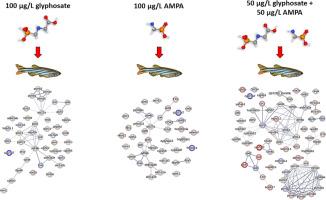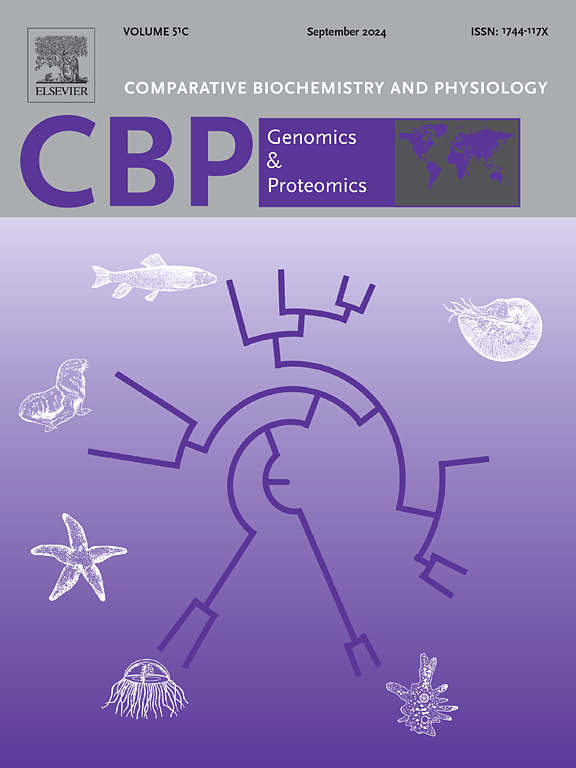Effects of environmentally relevant concentrations of glyphosate and aminomethylphosphonic acid on biotransformation and stress response proteins in the liver of zebrafish (Danio rerio)
IF 2.2
2区 生物学
Q4 BIOCHEMISTRY & MOLECULAR BIOLOGY
Comparative Biochemistry and Physiology D-Genomics & Proteomics
Pub Date : 2024-11-22
DOI:10.1016/j.cbd.2024.101366
引用次数: 0
Abstract
Herbicides pose a threat to various non-target organisms, including fish. A widely used herbicide, glyphosate, and its main breakdown product, aminomethylphosphonic acid (AMPA), are quite ubiquitous in freshwater systems. The aim of this work was to analyze changes in the relative abundance of hepatic proteins participating in the biotransformation and response to chemical stress in adult zebrafish Danio rerio exposed to environmentally relevant concentrations of glyphosate (100 μg/L), AMPA (100 μg/L), and their mixture (50 μg/L + 50 μg/L) for two weeks. Proteomic analysis showed that the tested concentrations caused dysregulation of various biotransformation proteins, the most upregulated of which in all treatment groups was the Phase I enzyme cyp27a7. While glyphosate had a more pronounced impact on the biotransformation pathways, AMPA showed stronger interference with redox homeostasis. When acting together, the parent compound and its metabolite were more potent to disturb fish metabolic processes, including nucleotide metabolism and proteasome pathway, and to downregulate proteins known for their roles in protection from oxidative modifications of cellular constituents and disruption of redox signaling.

环境相关浓度的草甘膦和氨甲基膦酸对斑马鱼(Danio rerio)肝脏中生物转化和应激反应蛋白的影响
除草剂对包括鱼类在内的各种非目标生物构成威胁。广泛使用的除草剂草甘膦及其主要分解产物氨甲基膦酸(AMPA)在淡水系统中无处不在。本研究的目的是分析成年斑马鱼在暴露于环境相关浓度的草甘膦(100 μg/L)、AMPA(100 μg/L)和它们的混合物(50 μg/L + 50 μg/L)两周后,参与生物转化和对化学应激反应的肝脏蛋白质相对丰度的变化。蛋白质组分析表明,测试浓度导致了各种生物转化蛋白质的失调,其中在所有处理组中上调幅度最大的是 I 期酶 cyp27a7。草甘膦对生物转化途径的影响更为明显,而 AMPA 对氧化还原平衡的干扰更大。当母体化合物及其代谢物同时作用时,它们对鱼类代谢过程(包括核苷酸代谢和蛋白酶体途径)的干扰更强,对保护细胞成分免受氧化修饰和破坏氧化还原信号转导的蛋白质的下调作用也更强。
本文章由计算机程序翻译,如有差异,请以英文原文为准。
求助全文
约1分钟内获得全文
求助全文
来源期刊
CiteScore
5.10
自引率
3.30%
发文量
69
审稿时长
33 days
期刊介绍:
Comparative Biochemistry & Physiology (CBP) publishes papers in comparative, environmental and evolutionary physiology.
Part D: Genomics and Proteomics (CBPD), focuses on “omics” approaches to physiology, including comparative and functional genomics, metagenomics, transcriptomics, proteomics, metabolomics, and lipidomics. Most studies employ “omics” and/or system biology to test specific hypotheses about molecular and biochemical mechanisms underlying physiological responses to the environment. We encourage papers that address fundamental questions in comparative physiology and biochemistry rather than studies with a focus that is purely technical, methodological or descriptive in nature.

 求助内容:
求助内容: 应助结果提醒方式:
应助结果提醒方式:


